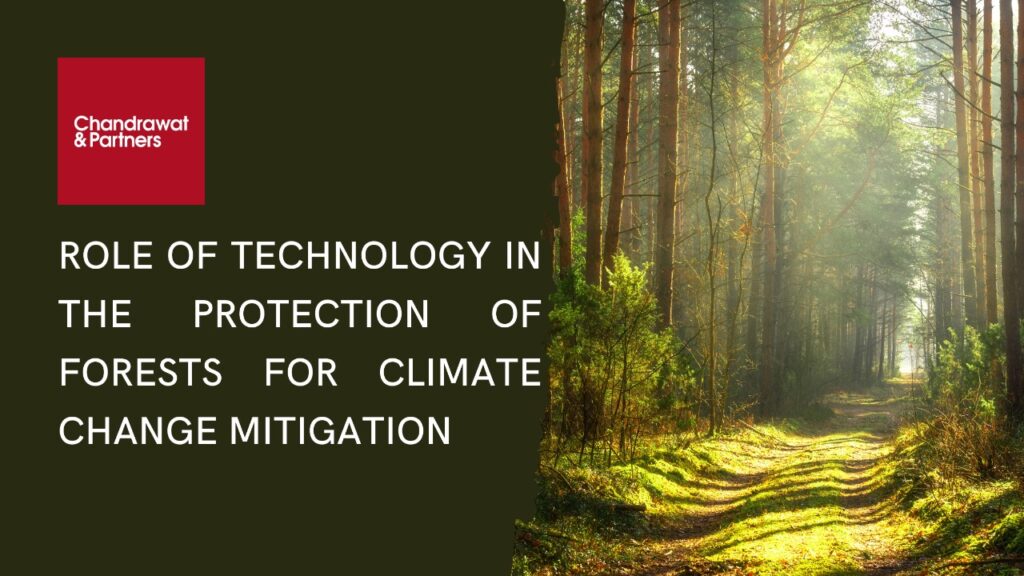Share :
Role of Technology in the Protection of Forests for Climate Change Mitigation
Climate change is a severe global threat facing developing and developed countries alike. It is caused by releasing Greenhouse Gases (GHGs) into the atmosphere, causing global warming. Carbon sinks are carbon reservoirs that take in and store more carbon (i.e., carbon sequestration) than they release. This helps to offset the GHG emissions partially. Forests and oceans are sizeable natural carbon sinks. Therefore, the protection and expansion of carbon sinks are effective strategies for mitigating climate change. Forests remove about one-fourth of the carbon that humans add to the atmosphere. Therefore, the protection and expansion of forest carbon sinks are essential to achieve global targets for carbon emission reduction.
Natural forest ecosystems which have thrived for hundreds of years, provide more efficient carbon sequestration services than newly planted forests or plantations. Therefore, while regenerating degraded forest land and afforestation are necessary, protecting the existing forest cover is critical. On-ground management and protection of Indian forests merit attention, and technology can play a major role in aiding the protection of forests in India.
Role of technology in the protection of Indian Forests
Climate change must be addressed through a holistic approach at all levels of engagement – policy, economic, social and political; technology is one of the key elements that can enable tangible outcomes.
It is imperative to understand the associated challenges to understand and facilitate technological interventions to protect existing forest cover. These can be broadly categorized as
I. Accurate measurement and prediction; and
II. Threats to forest ecosystems from anthropogenic causes like forest fires, illegal felling and forest land encroachment, slash-and-burn agriculture, land-use conversion, land degradation due to pollution, etc. Technologies to address these challenges broadly fall under the following categories:
- Forest carbon management:
To efficiently protect forests, it is essential to accurately measure the forest cover, carbon stock of the forests, and GHG emissions due to deforestation.
Procurement of reliable data, and relevant software for analysis to condense trends and make prediction models, are essential. With forests, systems to map biodiversity and forest health are also required.
Technological advancements in satellite imagery, such as hyperspectral imaging, allow for capturing granular details beyond the visible spectrum. Advanced analytic capabilities such as Machine Learning (ML) create intelligence by combining the data from multiple sources informed by climate science. The benefits of our technology advancements can thus translate into significant gains for forest carbon sink management.
- Surveillance and monitoring:
Another field of technology interventions pertains to surveillance and monitoring, which are applicable across various use cases. These can aid forest officials and personnel in ensuring the safety of protected forest areas, forest fires, illegal felling and poaching, and taking stock and track existing and new forest resources such as tree cover and wildlife.
Satellite data collection and analysis, drones with live feed and automatic path and flight modes, thermal sensors, and geofencing for animal tracking – are some examples of technology in the domain. Vehicles appropriately equipped to traverse forest terrains are also a requirement.
a). Forest fires
Humans are responsible for 75 per cent of all global wildfires, which is even higher for India. As per the Forest Survey of India (FSI), India also has approximately 11 per cent of its forest cover in the highly fire-prone zone. This is a serious cause for concern regarding the loss of carbon sinks and GHG emissions and, therefore, a crucial case for intervention.
Deployment of cameras around the vast forest area, coupled with Machine Vision (MV) and Artificial Intelligence (AI) to analyse real-time footage, can serve as a robust early warning system for forest fires and the human activity that causes them. Thermal sensors can be coupled with DAS (Distributed Antenna System) in forest fire-prone areas to detect any change in the ambient temperature conditions, thereby alerting the forest department of any excessive increase in the temperature. Protective helmets and vests with high-temperature tolerance, which allow greater safety and mobility through advanced materials (technical textiles), can protect the forest personnel involved in fire dousing. These technologies can also aid with other challenges in forest protection and management.
b). Illegal encroachment and felling of trees in forests
Human encroachment and illegal felling are challenging, particularly in protected forest areas, where surveillance and monitoring technology interventions will benefit. These pristine ecosystems are endangered due to illegal felling for industry, land encroachment by private actors, and even land use change for developmental activity. Forest officials spend significant resources and workforce patrolling Indian reserve forests to prevent illegal encroachment, felling, and human-wildlife conflict. It is a task that requires legislation to protect the area and round-the-clock vigilance to ensure that the legislative directions are complied with.
Monitoring technology used to check human activity for potential fire alerts can also be modified to check illegal felling and encroachment. Regular and detailed perimeter drone surveillance can help build on-ground intel and awareness for higher field control and shorter response time to such activities, augmenting the manual patrolling efforts by forest personnel.
c). Human-wildlife conflict
These monitoring technology interventions can also aid forest carbon sink preservation by protecting biodiversity, which is essential to maintain a functioning ecosystem. Various animals tend to stray past the boundary of forest areas and into the surrounding villages in search of food since there is no physical perimeter. This often leads to altercations between villagers and animals since the latter destroy farms and other valuable property, causing wildlife-animal conflicts which are detrimental to overall forest ecosystem health. MV and AI-enabled cameras deployed along forest boundaries can ensure the detection of animals straying beyond forest boundaries. Animals can also be equipped with non-invasive tracking devices with high location tracking accuracy via GPS (Global Positioning System). A robust technical intervention can provide a holistic solution to this challenge, coupled with animal tracking dashboards with geo and RFID (Radio-Frequency Identification) tags and geofences. Technical textiles which can protect personnel from animal attacks while ensuring mobility are also relevant interventions for this issue.
- Digital alert and relay systems:
Another category of technology interventions for forest management is digital alert and relay systems. Interventions which ensure quick access to information by forest personnel regarding any issues within the forests (such as forest fire or human encroachment and illegal felling alerts) will be an asset in forest carbon management.
Conclusion
Technology is not the only solution to protecting our forests, but it is an intervention which cannot be overlooked. It provides targeted solutions to specific problems, augments policy-making efforts, and boosts Indian innovation. Therefore, the role of technological interventions in forest management is crucial for achieving our climate change mitigation goals.
For more information or queries, please email us at
[email protected]






